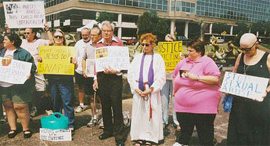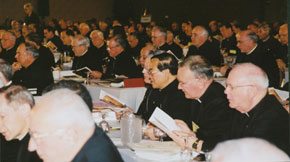
If anyone should know about the sexual abuse scandals, it is Prof. Patrick Schiltz. While in private practice from 1987-1995, he represented various churches in hundreds of clergy abuse cases. He now holds the St. Thomas More Chair in Law at the University of St. Thomas in Minneapolis and is still a consultant in abuse cases.
In the article, “Not All the News is Fit to Print,” in the August 15 issue of Commonweal, Prof. Schiltz grills the media and formulates a series of challenges that make a lot of sense. He suggests that maybe the whole story is not being told.
Summarizing the main points of the article, the challenges might be listed as follows:
Challenge #1: Cite a single major element in the present sexual abuse scandals that was not widely reported a decade ago.
Dr. Schiltz notes that although new names of priests and victims have appeared, the fact that several hundred priests were involved in abuse and bishops failed to act upon it is not new but rather old news. These subjects received unrelenting front-page coverage in the late 1980s and early 90s when many of these scandals first surfaced.
He also notes that never in the history of American journalism has a story covered so thoroughly in the past received so much coverage for months on end.

Challenge #2: Cite recent cases of child sexual abuse by clergy.
The biggest story of them all is ignored: sexual abuse of children by clergy over the last decade has practically disappeared.
Dr. Schiltz invites anyone to read every article about clerical sexual abuse reported by any major newspaper over the last two years. Almost none will deal with cases that occurred over the last decade.
The professor explains that after the spate of lawsuits in the 80s and early 90s, the churches did take action. Hundreds of offending pastors were removed from active ministry. New training and screening procedures were introduced. Churches invested millions of dollars in combating sexual misconduct.
The results of these policies are reflected in the dearth of new and recent abuse cases.
A significant example of this is in Boston. Despite all the exhaustive and thorough investigations carried out by the media and the attorney general of Massachusetts, not a single recent case was found. Similarly in Louisville, among the 185 lawsuits filed against the Archdiocese of Louisville, The Louisville Courier-Journal found only one that happened since 1990!
Challenge #3: Explain why no new victims come forward.
Many victim advocate groups will object to the above challenge explaining that recent victims will only appear after a long period of time due to the trauma and difficulty of reporting the experience. Dr. Schiltz does not accept that excuse.
He notes that, even in the past, some victims immediately came forward despite all obstacles. Yet today, almost none are doing so.
Moreover, Dr. Schiltz says that while such objections may have had some validity in the past, today the climate has changed entirely. Now it is easier not harder for victims to report abuse. Parents, teachers or parishioners are hyperalert to abuse symptoms. There should be more cases rather than less cases appearing.n>
Yet the media do not even question the mysterious lack of cases.
Challenge #4: Explain why no psychologists have been condemned by the media.
Part of the scandals consists of the fact that bishops returned priests to the ministry after receiving treatment. Dr. Schiltz notes that in most cases, the bishops relied on the bad advice of psychologists who either told the bishop that problematic priests did not abuse children or that the problem was under control. This had horrific consequences for the victims and the Church as a whole.
The media have ignored this fact and rarely will you find the psychologists taking the heat for their bad advice. These were supposed to be among the most respected professionals in their field. No one is calling for the resignations of these “experts.” No one is publishing exposes on their errors or naming them in multi-million dollar lawsuits.
No, the media are strangely silent in finding fault with them.
Challenge #5:Explain why the Catholic faithful are being made to pay for the damages.
The courts have consistently ruled against awarding damages where innocent victims are made to foot the bill. In the case of the Church, it is not the bishops or abusive priests that pay, but the faithful.
Dr. Schiltz cites several cases where courts struck down punitive damages against municipalities since the damages would be paid by innocent taxpayers. Labor unions have been protected in the same way. However, such protection of the innocent is not being applied to Catholic dioceses.
“To my knowledge,” Dr. Schiltz notes, “this is the first time in history in which punitive damages are routinely being inflicted upon the victims – or at least those completely innocent – of wrongful conduct.”
This extraordinary and newsworthy fact merits nary a mention in the media.
Indeed, as Dr. Schiltz points out, not all the news is fit to print. The media seem to have covered up a few points of their own. Moreover, the climate created by such reporting only serves to help those intent upon changing Church structures.
Next time, you are confronted by angry activists who lash out against oppressive Church structures, calmly ask them to take the Schiltz Challenge. The silence might be deafening.

